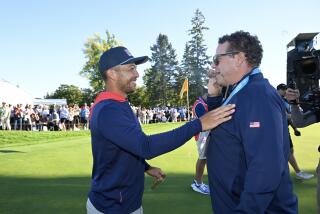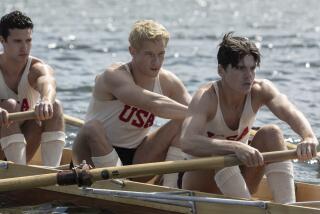It’s a Strange Sailing World Without Conner in the Mix
- Share via
AUCKLAND, New Zealand — Ask anyone on an American street to name a sailor and Popeye comes to mind, with Columbus a close second.
In U.S. sports consciousness, sailboat racing is a step above a coma, but every few years comes an event whose passionate nationalism draws interest well up the scale and revives awareness of a third sailor. For a quarter-century, Dennis Conner has been the lightning rod for that event, for all nationalities.
Some believe he is the event, Mr. America’s Cup. There is no A.C. without D.C.
But when the challenger final series starts here next Tuesday, it will be a best-of-nine contest between Paul Cayard’s AmericaOne team from San Francisco and Patrizio Bertelli’s Prada from Milan.
Where’s Dennis? And who is Patrizio Bertelli?
Bertelli is why Conner won’t be there.
He heads the high-fashion house that has sold enough handbags and baubles to invest $40 million to $50 million in winning a 149-year-old trophy that’s worth about $700 at current rates for silver.
The word around the waterfront is that his management style is more like Genghis Khan than Conner’s, but his employees deny it.
Operations manager Laurent Esquier, a Frenchman who lives in Rochester, N.Y., said, “If you see Italians shouting and pushing, that doesn’t mean they don’t love each other.”
On the other hand, Bertelli, who speaks limited English, said through an interpreter that he has enjoyed his first America’s Cup experience and is looking forward to some serious infighting in the finals.
“When the war is on, I enjoy it a lot,” he said.
Bertelli spent more time on his boats as the non-participating “17th man” than Conner did on his boat. However, Bertelli also is superstitious. He hasn’t ridden along since the day Prada’s mast fell.
A larger question is how his sailors--highly skilled but untested in the hand-to-hand combat they now face--will respond to Cayard’s gang of streetwise warriors. Like Conner, Cayard doesn’t blink.
Prada’s boats, designed by San Diego’s Doug Peterson, have sailed over Conner, three other U.S. teams and three other European teams, as well as a Japanese and an Australian entry.
They weren’t all pushovers, and Conner’s under-funded effort, in particular, overachieved to grow tough, especially in strong winds. With Ken Read at the helm, Stars and Stripes was 3-2 against AmericaOne and 2-3 against Prada.
Only at the end of the semifinals, when the wind didn’t blow hard enough, did Conner’s outfit falter. Dawn Riley’s America True, already eliminated, sailed brilliantly and trounced Stars and Stripes by 1 minute 32 seconds in a make-up race. That was the coup de grace for San Diego’s Cortez Racing Assn. entry and Prada’s pass into the challenger finals.
That night, an appreciative Prada sent a truckload of beer and champagne to True’s going-away party, as cannoned confetti drifted disrespectfully over Conner’s compound just next door.
It was his earliest exit in his eight America’s Cups since 1974--the first time he had failed to reach the defender or challenger finals. There was the sense of the end of an era about it.
It wasn’t only that he wasn’t on the boat this time. At 57, Conner has found his business skills as a manager and fund-raiser more valuable than his sailing. Now it’s easier to hire world-class sailors than it is to raise money for one of these campaigns.
Tom Whidden, 52, is president and chief executive of North Marine Group, the parent company of North Sails. He has been at Conner’s side as tactician through the seven campaigns run by Conner, who calls Whidden his best friend.
But the game has changed since they teamed up in Newport, R.I., in 1980.
“For sure, it’s different,” Whidden said. “A campaign was more manageable for a person like Dennis to manage financially . . . to raise 3 or 4 million dollars to have a pretty decent 12-meter campaign.
“The ante on the money side has gone up, and the ante on the perspective of all the various areas that are important has also been raised. It’s a very big thing to manage financially. For a guy like Dennis to do it himself is pretty spectacular. The day of it being able to be done without an independently wealthy person or a large company doing the whole thing itself, that day’s pretty much over.”
The night after Stars and Stripes was ousted, Conner wouldn’t say whether he would be back. It may depend on whether the Kiwis keep the Cup.
“We were very well embraced by the people here,” he said. “It’s a wonderful venue . . . [but] it’s very difficult to raise money for an America’s Cup in New Zealand.”
Conner is known for his sailing achievements only slightly more than for his outbursts of arrogance and mean-spirited attacks on perceived antagonists. His moods during occasional appearances in news conferences at the media center have swung from sarcastic to gracious to contrite.
“While I’m sorry not to go on, I’m very happy to have been here,” he said. “And I know this will be a very memorable America’s Cup. The best is yet to come.
“It’s good for ESPN because we have an American, Paul Cayard, the rising star of U.S. sailing, going up against Bertelli and his millions of dollars. It’s almost a dream story, isn’t it?”
If Prada versus Cayard is good business for the Cup, it’s also good business for Conner. In 1987 he switched his business from drapes to the America’s Cup, as well as the Whitbread Round the World Race, now the Volvo Ocean Race.
If either challenger wins, the sponsorship opportunities in the United States or Europe will be enhanced for Conner and other sailing entrepreneurs.
“You can make the case that San Francisco will be very exciting, or you can make another case that the South of France would breathe a whole new breath of life into the America’s Cup,” he said.
Conner’s geography wasn’t confused. He was just aware that should Prada win, it might choose not to defend on the waters of its Yacht Club Punta Ala, where there are few public accommodations or facilities, but at, say, St. Tropez.
That might cause a riot in Italy, in which case it has been suggested that Bertelli could compromise on the Italian island of Elba, where Napoleon spent some time, or more likely Sardinia.
This time, it just wasn’t to be. Maybe it was best for him and the Cup.
Stars and Stripes would have sailed into the finals and perhaps into the final match against Team New Zealand under a terrible cloud.
Early in the semifinals it came to light that Stars and Stripes had used a rudder that violated the rules in its first match, a 55-second victory over Nippon Challenge.
Nippon protested. Stars and Stripes was tried by the International Jury and found guilty.
The penalty was the deduction of one point--one win--from its score, which became critical. Stars and Stripes, which finished 6-3 in the semifinals, could have advanced to the finals with eight points by beating America True. As it was, Prada got in with seven and, thanks to America True, without the necessity of beating Stripes in a sail-off.
Didn’t Team Dennis Conner have a copy of the rules? Hadn’t anyone read them?
Unlike better-funded teams, Conner’s had no rules advisor to look after such details.
“We read this,” Conner said at the time. “We misinterpreted it. If we had thought that it was illegal, we wouldn’t have done it.”
Then he said, “It’s just redundant to keep going over and over it. It’s not helping the event, it’s not helping us, and it puts me in a bad mood.”
His mood did not improve a few days later. Prada’s twin race boats appear to command the entrance to the Viaduct Basin like the guns of Navarone. This time the Italians showed no mercy against a stricken foe and fired both barrels.
First, Prada filed a protest claiming that Stars and Stripes also had used a main sail that violated the rules.
When Stars and Stripes was eliminated, the protest was dropped, on an ominous note from Bryan Willis, chairman of the International Jury.
“The jury was concerned that the very serious allegations contained within the statement will not now be addressed,” Willis said.
In other words, Prada’s charges would go unproved, and Conner would not have a chance to clear his name.
Another issue lingered.
In a Catch-22 scenario, Prada had sent to the America’s Cup Arbitration Panel a document questioning whether Stars and Stripes would be a legitimate challenger for Team New Zealand, since it would not be able in good conscience to fulfill a requirement to sign an affirmation that it hadn’t broken any rules to get there.
With all of that, some friends of Conner and the Cup were relieved to see him go. Winning the challenger trials and then being disqualified would have been a disgrace for a proud man who has brought so much attention to sailing’s showcase event, often through achievement, sometimes through controversy.
He has enemies, but he also has friends. His crew’s loyalty borders on worship.
Headsail trimmer Mike Toppa said he returned to the grind for a single reason: “I wanted to do another Cup with Dennis.”
Navigator Peter Isler told of Conner’s pep talk to the team before the semifinals started:
“Even though he’s not on the boat very much, his will permeates the camp. He painted the picture, as only Dennis can, as to how the team should approach it. Any time Dennis starts talking about the big picture, it’s always worth listening, because in my experience the guy is just incredible when it comes to having a grip and an understanding of what it takes.”
As this Cup contest goes on without him, that’s a better way to remember Dennis Conner.
More to Read
Sign up for The Wild
We’ll help you find the best places to hike, bike and run, as well as the perfect silent spots for meditation and yoga.
You may occasionally receive promotional content from the Los Angeles Times.






